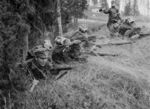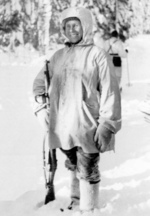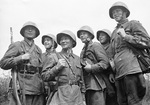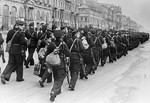Mosin-Nagant Rifle
| Country of Origin | Russia |
| Type | Rifle |
| Caliber | 7.620 mm |
| Capacity | 5 rounds |
| Length | 1.232 m |
| Barrel Length | 730.000 mm |
| Weight | 4.000 kg |
| Muzzle Velocity | 850 m/s |
Contributor: C. Peter Chen
ww2dbaseThe Mosin-Nagant series of bolt-action rifles were the results of combining the designs of Russian Army Captain Sergei Ivanovich Mosin and Belgian weapon designer Léon Nagant. The reason for the combined-design was largely a political comprise, appeasing those who favored Nagant's more efficient feeding system as well as those who favored a domestic design. That decision was made in 1891, two years after initial trials, and the production of the new Mosin-Nagant M1891 rifles began in the following year at Tula Arsenal, Izhevsk Arsenal, and Sestroryetsk Arsenal in Russia. A contract of 500,000 rifles was given to France, to be manufactured at Manufacture Nationale d'Armes de Châtellerault.By the Russo-Japanese War in 1904, approximately 3.8 million Mosin-Nagant M1891 rifles were in service. Some minor variants were also produced such as the Dragoon and Cossack Rifles variants, which were made lighter and shorter for mounted troops. The Model 1907 Carbines, variants made for use by engineering and signaling troops, were yet of another lighter variant of the original design.
When Russia became involved in WW1, demands for arms were so great that Russia decided to again contract foreign firms to produce them. A contract for 1.5 million Mosin-Nagan M1891 rifles were given to Remington Arms and 1.8 million to New England Westinghouse, both American manufacturers. Some of these Mosin-Nagant M1891 rifles were not delivered before the October Revolution that brought civil war to Russia, and they remained with British and American forces mainly for training purposes. Those in American service were designated "U.S. Rifle, 7.62mm, Model of 1916". Some of these American-built rifles were also given to Czechoslovak Legions in Siberia to aid their attempt to secure passage to France. During WW1, many of the Russian-built rifles were captured by German and Austro-Hungarian forces and saw further action on the other side of the conflict, largely with the German Navy and various rear-echelon forces. Many of these captured Russian rifles were sold to Finland in the 1920s, where the Finns had been using Mosin-Nagant M1891 rifles since they were a part of the Russian Empire until 1917.
In 1924, after the communists won the Russian civil war, the new government decided that the design was to remain in service, but a modernization was required. The result was the M1891/30 variant which began production in 1930. In 1932, 4x PE, 4x PEM, and 3.5x PU scopes were starting to be attached to limited numbers of them, making them excellent sniper rifles.
During the 1930s, the M1891/30 variant rifles were produced in mass quantities.
When Russia decided to take a side in the Spanish Civil War, many Mosin-Nagant M1891/30 rifles were sent to Spain to aid the Republican forces.
In 1938, the M1938 Carbines began to be produced. They were based on the M1891/30 variant rifles and were produced at the Izhevsk Arsenal between 1939 and 1945 and at Tula between 1940 and 1944.
Meanwhile, Finland embarked on their own efforts to produce their own versions of the Mosin-Nagant rifles; they were manufactured by SAKO, Tikkakoski, and VKT, with some using barrels imported from Switzerland and Belgium. Between the older models left in service from the Russian Empire days and the new models newly manufactured, when Russia and Finland became engaged in the Winter War in 1939, infantrymen on both sides found their enemies wielding the same weapons.
When the European War began in 1939, Mosin-Nagant M1891/30 rifles, being the standard rifles of the Soviet Army, were involved in nearly every battle. The sniper rifle variants also played an important role, earning their reputation as reliable and lethal weapons from urban battles such as the Battle of Stalingrad.
In late 1944, the M1944 Carbines replaced the M1938 Carbines in production. They shared the design of the M1938 predecessors, except that they had a permanently affixed bayonet, while M1938 did not accept any bayonets.
Between 1891 and the end of WW2 in 1945, 37 million Mosin-Nagant series of rifles and carbines were built; about 17.4 million of them were of the M1891/30 variant. They were made obsolete by the Soviet Army soon after the war, but continued to serve in other communist countries such as China, Korea, and Vietnam, with China continuing to manufacture them until the 1950s. 102,000 Finnish rifles of this design were built, with the final examples being made in the 1970s. At the time of writing, many Mosin-Nagant M1891/30 rifles are still in use in conflicts in Chechnya, Afghanistan, and Iraq as well as in civilian hands as hunting rifles or collectibles.
Source: Wikipedia. ww2dbase
Last Major Revision: Jan 2008
Mosin-Nagant Rifle Interactive Map
Photographs
 |  |  |  |
Did you enjoy this article or find this article helpful? If so, please consider supporting us on Patreon. Even $1 per month will go a long way! Thank you. Share this article with your friends: Stay updated with WW2DB: |
Visitor Submitted Comments
19 Nov 2009 07:25:58 AM
I have a spent shell casing jam. How do I remove it without damaging my rifle. I love it . The rifle was made in 1943 and served in wwII. It is a tack driver. Please help
5 Aug 2010 08:28:32 AM
i also have a 91/30 from izhevsk during 1943 if the casing is still one piece just slide the cleaning rod down the barrel if its broke in half you will need a gunsmith or a special tool made just for broken shell caseings
16 Nov 2010 03:01:15 PM
These are awesome rifles. I have 7 of them. They are so rich in history that I am facinated by them. Keep on with the history. If they could only talk...So much fun to shoot. I was always thinking about the AK's and other autoloaders, but these are more fun and sort of a challenge to shoot.
13 Dec 2010 04:30:38 AM
my girlfriends son has one of these rifles and is wanting a scope for it. where will i be able to find one?
12 Jan 2011 06:44:42 AM
i own an m44
15 May 2011 05:31:34 PM
cool
26 Nov 2011 08:44:46 AM
I own a assortment of these rifles. three model 91/30s 1 model 44,and a sako made model 1891.they are all good shooters.everyone should get one.cheap and cheap ammo
30 Dec 2011 07:05:23 AM
I have a 1928 model, how rare is it?
29 Jan 2018 05:53:23 AM
was the 1946 m44 used in wartime ?
5 Dec 2021 10:53:18 PM
I brought just the barrel and the bolt with no sites no wood at all it has Soviet writing and the date 1919 the numbers all match I would love to see it go to restore someone's gun it has Tula stamp the older spring in it bolt moves smooth but it to much for me to restore I will post on eBay I didn't pay a lot so I will let it go cheep
17 Feb 2023 04:48:23 PM
I just bought a mosin date 1932, Serial 89579 w/b foe $350.00 v/n shape did I go wronge?
All visitor submitted comments are opinions of those making the submissions and do not reflect views of WW2DB.
- » Wreck of USS Edsall Found (14 Nov 2024)
- » Autumn 2024 Fundraiser (7 Nov 2024)
- » Nobel Peace Prize for the Atomic Bomb Survivors Organization (11 Oct 2024)
- » Wreck of USS Stewart/DD-224 Found (2 Oct 2024)
- » See all news
- » 1,150 biographies
- » 337 events
- » 43,917 timeline entries
- » 1,241 ships
- » 350 aircraft models
- » 207 vehicle models
- » 374 weapon models
- » 123 historical documents
- » 260 facilities
- » 470 book reviews
- » 28,541 photos
- » 432 maps
George Patton, 31 May 1944
Please consider supporting us on Patreon. Even $1 a month will go a long way. Thank you!
Or, please support us by purchasing some WW2DB merchandise at TeeSpring, Thank you!
9 Mar 2009 07:06:41 AM
I am the proud owner of a Mosin nagant 91 30 and appreciate articles speaking of the way to learn on it - please do continue